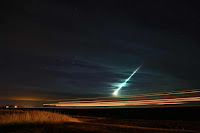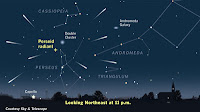Each year between 15 and 18 November (approximately), typically peaking between midnight and dawn on 18 November, the the Earth
encounters the Leonid Meteors, one of the more spectacular of the annual
meteor showers. Unlike most such showers, which are essentially
composed of dust particles, the Leonids comprise particles of up to 8 mm
across and up to 85 g in mass, leading to some spectacular fireballs,
and each year the shower is thought to deposit 12-13 tonnes of material
on the Earth. The Leonid Meteor Shower is so called because the meteors
they appear to originate in the constellation of Leo. (Note a meteor is a
'shooting star', a piece of material visibly burning up in the
atmosphere and detectable via the light it produces when doing this; a
meteorite is a piece of rock that has fallen from the sky and which a
geologist can physically hold; and an asteroid is a chunk of rock in
orbit about the Sun, to small to be regarded as a planet.
The radiant point (apparent point of origin) of the Leonid Meteors in 2015. Note the position of Jupiter, which will be close to the radiant this month. EarthSky.
The Leonid Meteors are thought to originate from the tail of Comet
55P/Tempel-Tuttle, which orbits the Sun every 33 years, on an orbit that
brings it slightly within the orbit of the Earth then out to slightly
beyond the orbit of Uranus. Comets are composed largely of ice (mostly
water and carbon dioxide), and when they fall into the inner Solar
System the outer layers of this boil away, forming a visible tail (which
always points away from the Sun, not in the direction the comet is
coming from, as our Earth-bound experience would lead us to expect).
Particles of rock and dust from within the comet are freed by this
melting (strictly sublimation) of the comet into the tail and continue
to orbit in the same path as the comet, falling behind over time.
The orbit and current position of 55P/Tempel-Tuttle. JPL Small-Body Database Browser.
The material in the meteor shower is densest close behind the comet, and, since Comet 55P/Tempel-Tuttle has a 33 year orbit, the
Leonid Meteor Shower has a 33-year cycle, with a particularly
spectacular display every thirty-third year, then a gradual decline in
meteor number till the end of the cycle. The last such peak year was in
1998.
See also...
 Bright fireball over Saskatchewan and Manitoba. Many people have reported seeing a bright fireball over parts of
southern Saskatchewan and Manitoba at about 8.40 pm local tine on Sunday
8 November 2015. A fireball is defined as a meteor (shooting star)...
Bright fireball over Saskatchewan and Manitoba. Many people have reported seeing a bright fireball over parts of
southern Saskatchewan and Manitoba at about 8.40 pm local tine on Sunday
8 November 2015. A fireball is defined as a meteor (shooting star)... Fireball over northern Europe. Eyewitnesses across much of northern Europe reported seeing a bright
fireball in the sky moving southwest to northeast at about 6.05 pm GMT
on Saturday 31 October 2015. The event was seen from the Netherlands,
Germany, Denmark, southern...
Fireball over northern Europe. Eyewitnesses across much of northern Europe reported seeing a bright
fireball in the sky moving southwest to northeast at about 6.05 pm GMT
on Saturday 31 October 2015. The event was seen from the Netherlands,
Germany, Denmark, southern... The 2015 Perseid Meteors. The
Perseid Meteor shower lasts from late July to early September each
year, and are expected to be at a peak on 12-13 August 2015, which
falling slightly before the...
The 2015 Perseid Meteors. The
Perseid Meteor shower lasts from late July to early September each
year, and are expected to be at a peak on 12-13 August 2015, which
falling slightly before the...Follow Sciency Thoughts on Facebook.


